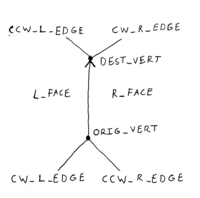Winged edge

Okay, imagine you have a piece of paper with a square drawn on it. You want to turn that square into a cube by adding lines and making folds. This is just like how computer programs turn flat things into 3D shapes on the screen.
To do this, we need to keep track of which lines connect to which other lines. For example, if you draw a line from the top left corner of the square to the top right corner, we need to remember that these two lines are now connected.
Now, imagine we draw another line from the top right corner down to the bottom right corner, forming a right angle. We also need to remember that these lines are connected too.
This is where the Winged Edge comes in. It's like a map that tells us which edges (the lines) connect to which faces (the squares or rectangles formed by the lines). It also tells us which faces are next to each other and which edges are shared between them.
So, in our cube example, we would use the Winged Edge to help us keep track of all the lines and faces that make up the cube. This helps us know where to make folds and how to turn a flat square into a 3D cube.
Overall, the Winged Edge is a way to organize information about the lines and faces in a 3D shape so we can work with it more easily. It's like a special map that helps us know which way everything is connected.
To do this, we need to keep track of which lines connect to which other lines. For example, if you draw a line from the top left corner of the square to the top right corner, we need to remember that these two lines are now connected.
Now, imagine we draw another line from the top right corner down to the bottom right corner, forming a right angle. We also need to remember that these lines are connected too.
This is where the Winged Edge comes in. It's like a map that tells us which edges (the lines) connect to which faces (the squares or rectangles formed by the lines). It also tells us which faces are next to each other and which edges are shared between them.
So, in our cube example, we would use the Winged Edge to help us keep track of all the lines and faces that make up the cube. This helps us know where to make folds and how to turn a flat square into a 3D cube.
Overall, the Winged Edge is a way to organize information about the lines and faces in a 3D shape so we can work with it more easily. It's like a special map that helps us know which way everything is connected.
Related topics others have asked about:
